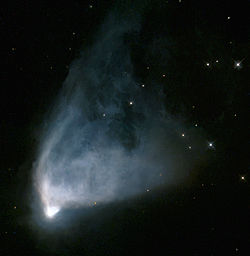| Observation data Epoch J2000 Equinox J2000 | |
|---|---|
| Constellation | Monoceros |
| Right ascension | 06h 39m 09.954s [1] |
| Declination | +08° 44′ 09.56″ [1] |
| Apparent magnitude (V) | 11.85 [2] |
| Characteristics | |
| Spectral type | B8IIIev [3] |
| Variable type | Herbig Ae/Be star [2] |
| Astrometry | |
| Distance | 2600 ly (800 [4] pc) |
| Details | |
| Mass | ~2–10 [5] M☉ |
| Age | ~105 yr [5] years |
| Other designations | |
| R Mon, BD+08°1427, 2MASS J06390995+0844097, NGC 2261 [2] | |
| Database references | |
| SIMBAD | data |
R Monocerotis, abbreviated R Mon, is a very young binary star [5] system in the equatorial constellation of Monoceros. The apparent magnitude of R Mon varies between 10 and 12 and the spectral type is B8IIIe. [3]
Contents

This is a massive Herbig Ae/Be star, a type of pre-main-sequence star that is surrounded by an orbiting circumstellar disk of gas and dust. This disk has a mass of ~0.007 M☉ and extends outward to a distance of under 150 AU from the host. Because of this dust, the star is obscured from direct visual sight but can still be observed in the infrared. [5] R Mon is still in the accretion phase of star formation and it is driving an optically opaque bipolar outflow with a velocity of 9 km/s. The northern flow is blue-shifted, and thus moving more toward the Sun. [7] There is a T Tauri-type stellar companion at an angular separation of 0.69″ from the primary. [5]
This system is located in a diffuse nebula called "Hubble's Variable Nebula" (NGC 2261), which is being illuminated by a conical beam of light from the primary. [5]
